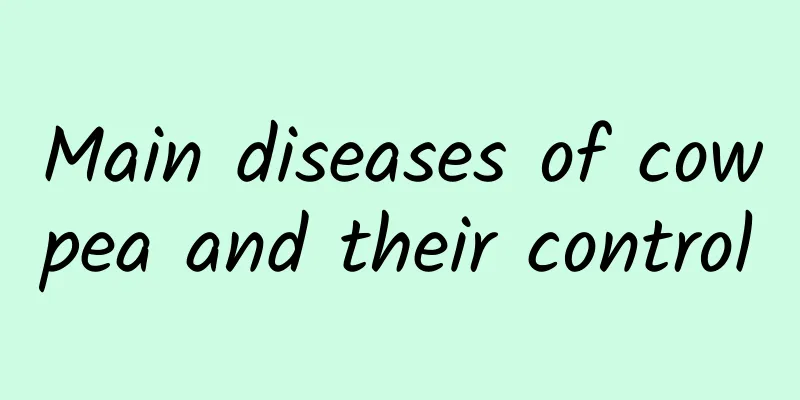Main diseases of cowpea and their control

|
Cowpeas are usually planted in autumn, so you may encounter various problems during the planting process. Today I will tell you about cowpea diseases and prevention methods: 1. Cowpea virus disease:It is a common and serious disease. Common ones include cowpea mosaic and cowpea yellow mosaic. The main viral pathogens are cowpea aphid-transmitted mosaic virus and cucumber mosaic virus. The leaves show yellow spots, yellow-green and dark green spots, and deformities. In severe cases, the plants are short and even cannot bloom and die. Prevention and control: Establish disease-free seed fields, select disease-resistant varieties, select seeds, cultivate strong seedlings, and improve the disease resistance of the plants themselves; implement crop rotation to avoid continuous planting, strengthen fertilizer and water management, and increase the application of phosphorus and potassium fertilizers; remove and burn diseased plants and leaves in time to reduce the source of disease. Before or at the beginning of the disease, use 200 times Bordeaux mixture or 500-800 times of 50% carbendazim wettable powder, or 600-1000 times of 50% thiophanate wettable powder and other fungicides to prevent fungal diseases. If aphids are found, spray 40% dimethoate emulsion 1000 times or 80% dichlorvos emulsion 1000-1500 times to prevent and control aphids, focusing on spraying the back of leaves. Eliminate the virus source. After the virus disease occurs, add more fertilizer and water, and spray 0.1%-0.5% potassium dihydrogen phosphate to reduce losses. 2. Cowpea sooty mold disease:Also known as leaf mold or leaf spot, it is a leaf disease that has occurred more seriously in recent years. In the early stage, small red and purple-brown spots appear on the leaves, which expand into nearly circular spots. When it is humid, gray-black mold will appear on the back of the leaves, causing the leaves to become smaller, fall off, and reduce pod formation. Prevention and control: Strengthen field management, reasonably densely plant, make the field ventilated and light-permeable, prevent excessive humidity, increase phosphorus and potassium fertilizers, improve plant disease resistance, remove diseased leaves at the early stage of the disease, clean the field after harvest, and reduce the spread of the disease. Chemical control: 1:1:200 Bordeaux mixture, 400 times of 25% carbendazim wettable powder, or 500 times of 50% thiophanate-methyl wettable powder, or 600 times of 75% chlorothalonil wettable powder, or 500 times of 65% mancozeb wettable powder can be used once every 10 days, and control 2-3 times continuously. 3. Cowpea rust:The main damage is to the leaves, and in severe cases, petioles and seed pods may also be damaged. At first, small yellowish spots appear on the back of the leaves, gradually turning brown, and the bulges appear like small pustules, which then expand into summer spores. After the epidermis breaks, reddish-brown powder, namely summer spores, is scattered, and black winter spores are formed later, causing the leaves to deform and fall early. Prevention and control: Choose disease-resistant varieties, spray 15% triadimefon wettable powder 1000-1500 times or 50% carboxin emulsifiable concentrate 800 times at the early stage of the disease, once every 10-15 days, and spray 2-3 times in a row. 4. Powdery mildew of cowpea:The main damage is to the leaves, but also to the vines and pods. Yellow-brown spots appear on the back of the leaves at first, and then expand into purple-brown spots, covered with a thin layer of white powder. The leaf spots develop along the veins, and the white powder covers the entire leaf, causing a large number of leaves to fall. This disease is common in the south. Prevention and control: Use disease-resistant varieties, remove diseased and damaged plants in time after harvest, and burn or bury them in a concentrated manner; spray 500 times of 70% methyl thiophanate wettable powder or 150 times of 30% solid lime sulfur mixture, 300 times of 50% sulfur suspension at the early stage of the disease, spray once every 7-10 days, and continue 3-4 times. 5. Cowpea wilt:The main disease in the seedling stage. Symptoms include root rot and plant wilting. It can be prevented and controlled mainly by crop rotation, removal of diseased plants, and strengthening field management. |
<<: Cowpea pest control methods
>>: How to cook cowpea? Cowpea recipes
Recommend
The efficacy and function of sour jujube
Jujube has always been a particularly healthy gre...
International Aeronautical Federation_FAI review and website information
Fédération Aéronautique Internationale (FAI) is an...
Ingredients and steps for making wolfberry leaf and sheep kidney porridge
Sheep kidney porridge is a common porridge nowada...
How to cook persimmon cabbage together, how to cook persimmon cabbage
How to cook persimmon and cabbage together? Let m...
How is Egypt Trade Network? Egypt Trade Network Reviews and Website Information
What is Egypt Trade Network? Egypt Trade Network w...
Dried shiitake mushrooms have high nutritional value
It is good for the elderly to eat dried mushrooms...
Effects and edible methods of Dendrobium powder
Dendrobium powder is a light brown powder obtaine...
Another Photography Studio Review and Website Information
What is Another Photography Studio? Another Photog...
What is the Estudiantes de La Plata Football Club like? Estudiantes de La Plata Football Club reviews and website information
What is the website of Club Estudiantes de La Plat...
What are the benefits of eating pomegranate seeds?
Pomegranate seeds are a composite fruit. A big po...
What is G-Shock like? G-Shock reviews and website information
What is G-Shock? G-Shock is a watch brand produced...
Steps for making lettuce with oyster sauce
I don’t know if you have heard of lettuce with oy...
The efficacy and function of mulberry wine. The benefits of drinking mulberry wine for women
Mulberry wine is a natural fruit wine made from m...
What is Symantec? Symantec reviews and website information
What is Symantec? Symantec is one of the world'...
Ingredients and methods of cooking broad beans with onion
Today I’m going to tell you how to make scallion-...









